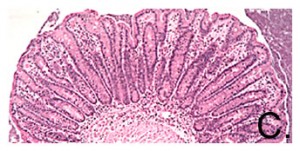Etiology: Helicobacters are Gram-negative, microaerophilic spiral motile bacteria. Helicobacter hepaticus, H. bilis, H. rodentiumH. trogontum, H. ganmani and H. typhlonius are species of helicobacter that colonize and may cause disease in laboratory mice. Other helicobacters have been identified but so far have not been associated with a disease condition.
Incidence: The incidence of infection with Helicobacter is common.
Transmission: The mode of transmission is by the fecal-oral route. Rodent helicobacters normally colonize the lower intestinal tract, and can be transmitted to naive mice through contact with feces-laden bedding, although transmission is spotty. H. hepaticus and H. bilis are also capable of colonizing bile canaliculi in susceptible mouse strains. Other rodents, including rats and hamsters, can be colonized by these helicobacters, but do not develop disease. However, these infected rodents may serve as reservoirs of bacteria in animal facilities.
Clinical Signs: Most mice colonized with helicobacters remain asymptomatic for long periods of time. Certain strains of mice will develop a proliferative, inflammatory typhlitis and/or colitis that may result in rectal prolapse.

Pathology: Mouse genotype, age, gender, and the bacterial species all influence development of lesions. Disease develops in susceptible mice over 6 months of age. Helicobacter hepaticus and H. bilis induce a chronic active hepatitis often with necrosis, portal lymphocytic infiltrates and oval cell hyperplasia (A.) in susceptible mouse strains including A/J, BALB/c, C3H and immunodeficient mice (SCID mice and mice with genetically engineered immune defects). Of the immunocompetent susceptible strains, male mice develop liver disease which may progress to hepatic carcinoma. Helicobacter hepaticus can be visualized as small helical organisms in bile canaliculi on silver stained sections (arrowheads, B.). Helicobacter bilis is less often observed in silver stained liver sections.
Certain strains of mice develop intestinal disease from helicobacter colonization. Helicobacters in general can serve as a “trigger” to promote gut inflammation in IL10 -/- mice. Female A/J strain mice colonized with H. hepaticus often develop an inflammatory bowel disease characterized by mucosal hyperplasia with erosions/ulcers, mixed inflammatory infiltrate and rectal prolapse (C.). Immunodeficient mice of either sex can develop both liver and intestinal disease.

Diagnosis: Helicobacters can be detected by PCR testing and histopathology. PCR of feces is the most sensitive and rapid diagnostic method used for screening rodents for infection. Histopathologic examination of the liver with visualization of characteristic bacteria is diagnostic; however, not all mice infected with pathogenic helicobacters develop histologic lesions, and not all colonized mice with liver disease have bacteria in the liver.